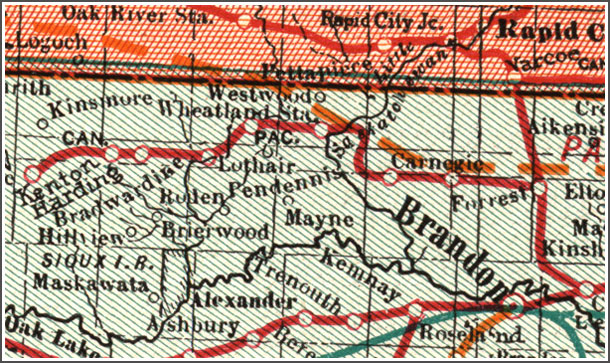|
The
Lenore
Branch - Rail Service at Last!
As the district was becoming settled between 1880 and 1890, there was a
boom in new railway line construction across western Manitoba.
In 1890 the Great Northwest Central began a service linking the CPR
Main Line at Brandon to towns to the north. To facilitate the steep
climb up out of the Assiniboine Valley it actually connected west of
Brandon and angled gently up the slope before turning north. The CPR
later took over this line, as it did with many others.
 In 1902
the GNCR added a branch at Forrest that went west as far as Lenore,
bringing much appreciated service.
In 1902
the GNCR added a branch at Forrest that went west as far as Lenore,
bringing much appreciated service.
Carnegie
The first stop was Carnegie, selected for no other reason than the
business decision to provide elevators every 8-12 kilometres. The land
was purchased from William Carnegie, said to be the second cousin of
industrialist and philanthropist Andrew Carnegie. Before long it had a
post office, two elevators, and a blacksmith shop, along with a section
house. Watt’s General Store served the small community and the outdoor
skating rink hosted a pretty fair hockey team. The post office closed
in 1960 and nothing remains at the site but a cairn along the old
railway grade.

Pendennis
The next stop was Pendennis. In this case the name was already there,
or nearby, identifying a post office located near a crossing of the
Little Saskatchewan River. As often happened, the Post Office moved,
taking the name along with it.


The map shows all the rail lines that eventually crossed the region.
But between 1902 and 1908 the
Lenore line was the sole link to the rest of the province. Notice
how that line takes quite a jog to the north before crossing the river
and heading west again?
Railways will go to some lengths, literally, to find the easiest place
to cross a river. Surveyors look for a gentle grade and a short
crossing. At the crossing, near the original location of Pendennis,
they built a water tower and a siding called Cossar Crossing.
The site was really close to Wheatland, in fact was sometimes referred
to as the Wheatland Crossing, and would only have been established
because of the ready supply of water at the river.
 The Cossar
Crossing site today.
The Cossar
Crossing site today.
Wheatland however did become quite a town. Like Pendennis, it had
existed as a post office for some time in a location quite a distance
to the north. Had the Grand Trunk Pacific not decided to build its line
so close, and to establish a divisional point at Rivers, Wheatland
would naturally have become the service centre for the region.
At one time, the Canadian Pacific Railway ran tri¬-weekly mixed freight
and passenger trains on the Forrest/Brandon to Lenore line. The line
has been long since abandoned, the rails have been removed, and the
railway lands returned to agriculture. The little villages of Carnegie
and Pendennis are gone while Wheatland and Bradwardine have a few
scattered buildings.
|